地下水污染来源 英文
- 格式:ppt
- 大小:802.00 KB
- 文档页数:8
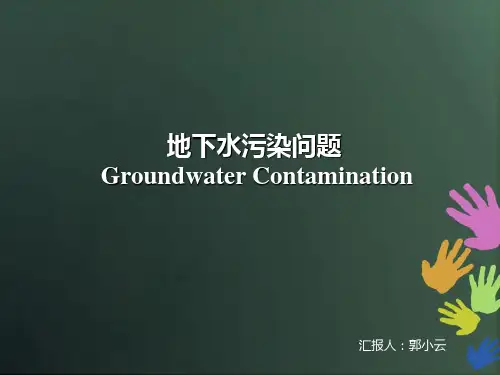

Ppt1Here I’d show the water pollutants and their sources.Ppt2The wide range of pollutants discharged to surface waters can be grouped into broad classes, as shown in Table .Domestic sewage and industrial wastes are called point sources.Urban and agricultural runoff are called non-point sources.[də'mestɪk] ['su:ɪdʒ]生活污水城市和农业径流Ppt3Here I list some contaminants[kən'tæminənt]The Oxygen-demanding material 需氧物质Nutrients ['nju:triənt]营养物质Pathogens Organisms['pæθədʒəns]病原微生物Suspended solids or sediments['sɛdəmənt]沉积物SaltsToxic metals['tɒksɪk] 有毒金属And we will discuss them later.Ppt4 Point sourcesFirst the point sources.Domestic sewage and industrial wastes are called point sources because they are generally collected by a network of pipes or channels and conveyed to a single point of discharge into the receiving water.As is shown in the picture.Channels ['tʃænlz]通道,水槽Domestic sewage consists of wastes from homes, schools, office buildings, and stores.The term municipal sewage is used to mean domestic sewage into which industrial wastes are also discharged.municipal sewage[mjʊ'nɪsɪp(ə)l]城市污水In general, point source pollution can be reduced or eliminated through waste minimization and proper wastewater treatment prior to discharge to a natural water body.eliminated[ɪ'lɪmɪnetɪd]消除minimization[,mɪnɪmɪ'zeʃən]最小Prior['praɪə]在前Under the Federal Water Pollution Control Act of 1972 some animal feeding operations (AFOs) may be designated as a point source.AFOs are designated point sources if the feeding operation may be classified as a concentrated animal feeding operation (CAFO).AFOs is an organophosphorus pesticidesFedaral 联邦AFOs 灭蚜磷Designated ['dɛzɪg,netɪd]指定的organophosphorus[,ɔːg(ə)nəʊ'fɒsf(ə)rəs]有机磷pesticides['pestɪsaɪdz]杀虫剂Ppt5 Non-point sourcesUrban and agricultural runoff are characterized by multiple discharge points. These are called non-point sources.['mʌltɪpl]多个城市和农业径流具有多个放电点。
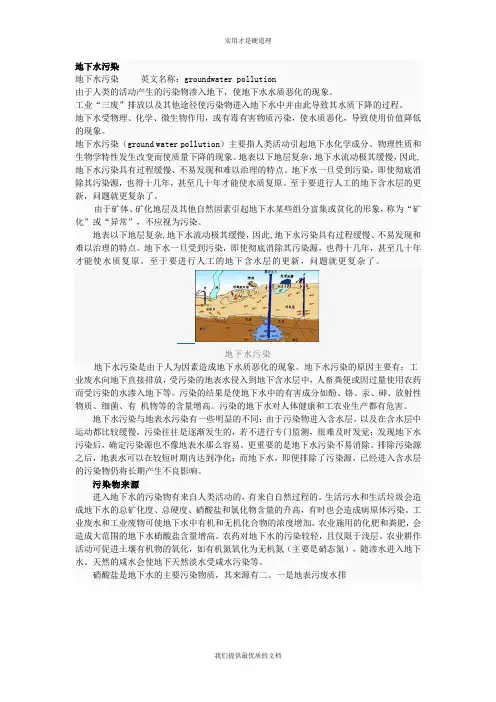
地下水污染地下水污染英文名称:groundwater pollution由于人类的活动产生的污染物渗入地下,使地下水水质恶化的现象。
工业“三废”排放以及其他途径使污染物进入地下水中并由此导致其水质下降的过程。
地下水受物理、化学、微生物作用,或有毒有害物质污染,使水质恶化,导致使用价值降低的现象。
地下水污染(ground water pollution)主要指人类活动引起地下水化学成分、物理性质和生物学特性发生改变而使质量下降的现象。
地表以下地层复杂,地下水流动极其缓慢,因此,地下水污染具有过程缓慢、不易发现和难以治理的特点。
地下水一旦受到污染,即使彻底消除其污染源,也得十几年,甚至几十年才能使水质复原。
至于要进行人工的地下含水层的更新,问题就更复杂了。
由于矿体、矿化地层及其他自然因素引起地下水某些组分富集或贫化的形象,称为“矿化”或“异常”,不应视为污染。
地表以下地层复杂,地下水流动极其缓慢,因此,地下水污染具有过程缓慢、不易发现和难以治理的特点。
地下水一旦受到污染,即使彻底消除其污染源,也得十几年,甚至几十年才能使水质复原。
至于要进行人工的地下含水层的更新,问题就更复杂了。
地下水污染地下水污染是由于人为因素造成地下水质恶化的现象。
地下水污染的原因主要有:工业废水向地下直接排放,受污染的地表水侵入到地下含水层中,人畜粪便或因过量使用农药而受污染的水渗入地下等。
污染的结果是使地下水中的有害成分如酚、铬、汞、砷、放射性物质、细菌、有机物等的含量增高。
污染的地下水对人体健康和工农业生产都有危害。
地下水污染与地表水污染有一些明显的不同:由于污染物进入含水层,以及在含水层中运动都比较缓慢,污染往往是逐渐发生的,若不进行专门监测,很难及时发觉;发现地下水污染后,确定污染源也不像地表水那么容易。
更重要的是地下水污染不易消除。
排除污染源之后,地表水可以在较短时期内达到净化;而地下水,即便排除了污染源,已经进入含水层的污染物仍将长期产生不良影响。
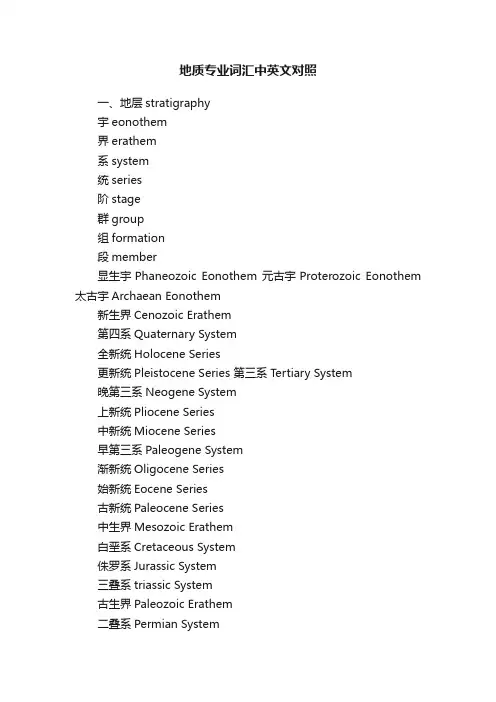
地质专业词汇中英文对照一、地层stratigraphy宇eonothem界erathem系system统series阶stage群group组formation段member显生宇Phaneozoic Eonothem 元古宇Proterozoic Eonothem 太古宇Archaean Eonothem新生界Cenozoic Erathem第四系Quaternary System全新统Holocene Series更新统Pleistocene Series 第三系Tertiary System晚第三系Neogene System上新统Pliocene Series中新统Miocene Series早第三系Paleogene System渐新统Oligocene Series始新统Eocene Series古新统Paleocene Series中生界Mesozoic Erathem白垩系Cretaceous System侏罗系Jurassic System三叠系triassic System古生界Paleozoic Erathem二叠系Permian System石炭系Carboniferous System泥盆系Devonian System志留系Silurian System奥陶系Ordovician System寒武系Cambrian System新元古界Neoproterozoic Erathem震旦系Sinian System中元古界Mesoproterozoic Erathem 古元古界Palaeoproterozoic Erathem 地层对比stratigraphic correlation 层位horizon标志层key bed哑层barren bed缺失lacuna尖灭feather edge透镜状结构lensoid连续continuity不连续discontinuity整合conformity不整合unconformity角度不整合angular unconformity平行不整合para-unconformity产状occurrence走向strike倾角dip真倾角true dip视倾角apparent dip倾伏角plunge侧倾角pitch层理bedding层面bedding planes交错层理cross bedding二、岩性lithology粘土clay粉质粘土silty clay砂sand砾石gravel沉积岩sedimentary rock火成岩igneous rock变质岩metamorphic rock粘土岩claystone, clay rock页岩shale泥岩mudstone粉砂岩siltstone泥质粉砂岩argillaceous siltstone, pelitic siltstone, muddy siltstone砂岩sandstone泥质砂岩argillaceous sandstone, pelitic sandstone, muddy sandstone砾岩conglomerate煤coal灰岩limestone泥灰岩marl, marlstone白云岩dolomite蒸发岩evaporite岩浆岩magmatic rock, magmatite 花岗岩granite玄武岩basalt凝灰岩tuff大理岩marble片麻岩gneiss夕卡岩skarn三、矿物mineral 石英quartz长石feldspar云母mica白云母muscovite 方解石calcspar角闪石hornblende 石膏gypsum硬石膏anhydrite 石盐rock salt钾石盐sylvine光卤石carnallite溢晶石tachydrite 水氯镁石bischofite 四、颜色colour灰色gray白色white黄色yellow蓝色blue绿色green黑色black红色red棕色brown黄褐色tan深色dark浅色light暗色dull五、构造tectonics 断层fault正断层normal fault逆断层reverse fault冲断层thrust走滑断层strike-slip fault 倾滑断层dip-slip fault 断层面fault surface断层线fault line地垒horst地堑graben节理joint上盘hanging wall下盘foot wall落差throw平错heave断层泥fault gouge断层角砾fault brecci海侵transgression海退regression褶曲fold背斜anticline向斜syncline褶轴fold axis轴隆区culmination轴陷区depression翼limb穹窿dome盆地basin六、水文地质hydrologic geology河流river水库reservoir泉spring地表水surface water地下水groundwater大气降水atmospheric precipitation潜水phreatic water承压水confined water层间水interstrated water地下水位groundwater level含水层aquifer, water bearing layer隔水层aquiclude, water-resisting layer 弱含水层aquitard透水层permeable bed孔隙含水层porous aquifer裂隙含水层fissured aquifer岩溶含水层karst aquifer无压含水层unconfined aquifer承压含水层confined aquifer含水岩组water-bearing formation 含水岩系water-bearing rock series 持水度water-holding capacity给水度specific yield透水性permeability富水性water yield property溶洞karst cave孔隙水pore water裂隙水fissure water岩溶水karst water补给区recharge area径流区runoff area排泄区discharge area地下径流underground runoff地下水排泄groundwater discharge降水补给precipitation recharge地表水补给surface water recharge越流补给leakage recharge水文地质单元hydrogeological unit地下水赋存条件 groundwater occurrence水文地质条件hydrogeological condition 水文地质类型hydrogeological type地下水储存量groundwater storage地下水监测groundwater monitoring抽水试验pumping test注水试验injection test入渗试验Infiltration test水文调查hydrologic investigation渗透系数osmotic coefficient矿床充水flooding of ore deposit矿床充水条件flooding condition of ore deposit矿床充水水源Water source of ore deposit flooding 矿床充水通道flooding passage in ore deposit充水岩层flooding layer老窿水goaf water矿坑涌水量water yield of mine正常涌水量normal water yield最大涌水量maximum water yield大井法Large diameter well method开采疏干simultaneous draining in mining地下疏干underground draining地表疏干surface draining疏干钻孔drain well疏干巷道draining tunnel矿井突水water bursting in mines突水点water bursting point防水矿柱ore pillar preventing water burst矿井堵水water blocking in mines探水钻孔water exploration borehole注浆孔grouting well最高洪水位maximum flood level七、工程地质egineering geology顶板roof顶板稳定性roof stability顶板冒落带caving zone of top wall顶板裂隙带fissure zone of top wall顶板管理roof control顶板支护roof support顶板崩落collapse of roof底板floor, footwall底鼓footwall heaving岩石物理性质physical properties of rock岩石力学性质mechanical properties of rock 抗压强度compressive strength抗拉强度tensile strength岩爆rock burst软弱结构面weak structural plane工程地质条件engineering geologic condition 八、环境地质environmental geology岩崩rock fall滑坡landslide泥石流mud-rock flow地震earthquake地面沉降subsidence地面开裂land crack地面塌陷ground surface collapse塌陷坑collapse pit地下水污染groundwater pollution地表水污染surface water pollution污染源pollution source地下水资源枯竭 groundwater resource depletion地下水质恶化deterioration of groundwater quality 九、资源/储量resource/reserve矿产资源mineral resources储量reserves基础储量reserve base资源量resources可采储量proved reserves预可采储量probable reserves探明的measured控制的indicated推断的inferred预测的prognostic远景储量prospective reserves经济的economic边际经济的marginally economic次经济的subeconomic内蕴经济的intrinsically economic矿石ore矿层ore bed矿床ore deposit矿块ore block矿柱ore pillar, ore column矿石品位ore grade富矿体ore shoot, ore course 贫矿poor ore。
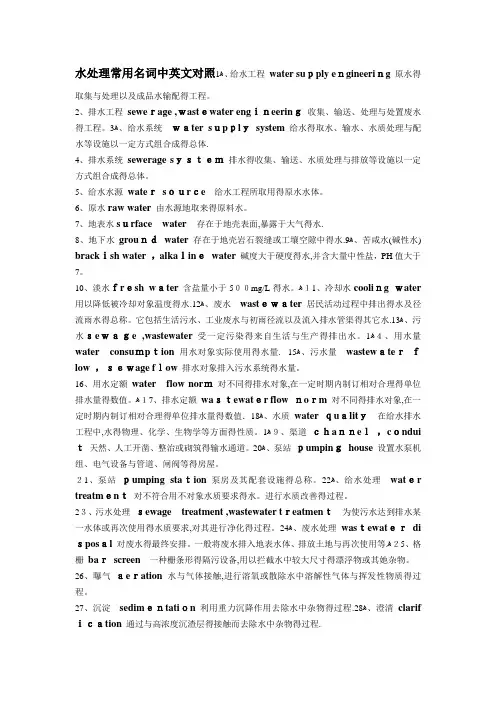
水处理常用名词中英文对照ﻫ1、给水工程water supply engineering原水得取集与处理以及成品水输配得工程。
2、排水工程sewerage ,wastewater engineering收集、输送、处理与处置废水得工程。
ﻫ3、给水系统water supplysystem给水得取水、输水、水质处理与配水等设施以一定方式组合成得总体.4、排水系统sewerage system排水得收集、输送、水质处理与排放等设施以一定方式组合成得总体。
5、给水水源watersource给水工程所取用得原水水体。
6、原水raw water由水源地取来得原料水。
7、地表水surface water存在于地壳表面,暴露于大气得水.8、地下水groundwater存在于地壳岩石裂缝或工壤空隙中得水.ﻫ9、苦咸水(碱性水) brackish water ,alkalinewater碱度大于硬度得水,并含大量中性盐,PH值大于7。
10、淡水fresh water含盐量小于500mg/L得水。
ﻫ11、冷却水cooling water12、废水wastewater居民活动过程中排出得水及径用以降低被冷却对象温度得水.ﻫ13、污流雨水得总称。
它包括生活污水、工业废水与初雨径流以及流入排水管渠得其它水.ﻫ水sewage ,wastewater受一定污染得来自生活与生产得排出水。
ﻫ14、用水量water consumption 用水对象实际使用得水量.- ﻫ15、污水量wastewaterflow ,sewage flow排水对象排入污水系统得水量。
16、用水定额water flow norm对不同得排水对象,在一定时期内制订相对合理得单位排水量得数值。
ﻫ17、排水定额wastewater flow norm对不同得排水对象,在一18、水质water quality在给水排水定时期内制订相对合理得单位排水量得数值.ﻫ工程中,水得物理、化学、生物学等方面得性质。
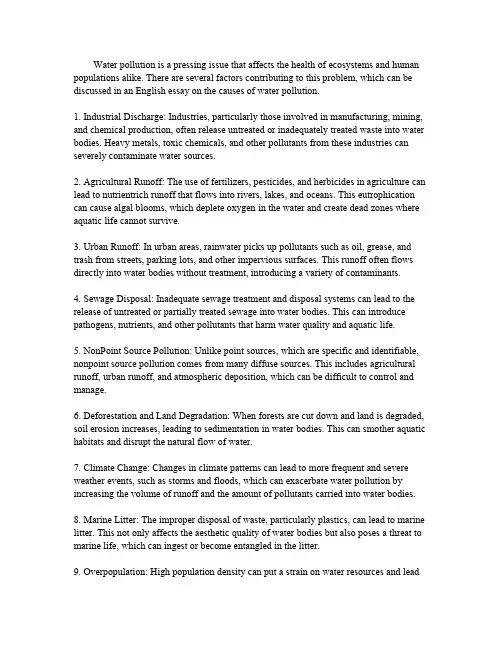
Water pollution is a pressing issue that affects the health of ecosystems and human populations alike.There are several factors contributing to this problem,which can be discussed in an English essay on the causes of water pollution.1.Industrial Discharge:Industries,particularly those involved in manufacturing,mining, and chemical production,often release untreated or inadequately treated waste into water bodies.Heavy metals,toxic chemicals,and other pollutants from these industries can severely contaminate water sources.2.Agricultural Runoff:The use of fertilizers,pesticides,and herbicides in agriculture can lead to nutrientrich runoff that flows into rivers,lakes,and oceans.This eutrophication can cause algal blooms,which deplete oxygen in the water and create dead zones where aquatic life cannot survive.3.Urban Runoff:In urban areas,rainwater picks up pollutants such as oil,grease,and trash from streets,parking lots,and other impervious surfaces.This runoff often flows directly into water bodies without treatment,introducing a variety of contaminants.4.Sewage Disposal:Inadequate sewage treatment and disposal systems can lead to the release of untreated or partially treated sewage into water bodies.This can introduce pathogens,nutrients,and other pollutants that harm water quality and aquatic life.5.NonPoint Source Pollution:Unlike point sources,which are specific and identifiable, nonpoint source pollution comes from many diffuse sources.This includes agricultural runoff,urban runoff,and atmospheric deposition,which can be difficult to control and manage.6.Deforestation and Land Degradation:When forests are cut down and land is degraded, soil erosion increases,leading to sedimentation in water bodies.This can smother aquatic habitats and disrupt the natural flow of water.7.Climate Change:Changes in climate patterns can lead to more frequent and severe weather events,such as storms and floods,which can exacerbate water pollution by increasing the volume of runoff and the amount of pollutants carried into water bodies.8.Marine Litter:The improper disposal of waste,particularly plastics,can lead to marine litter.This not only affects the aesthetic quality of water bodies but also poses a threat to marine life,which can ingest or become entangled in the litter.9.Overpopulation:High population density can put a strain on water resources and leadto increased pollution due to the greater demand for water and the production of more waste.ck of Public Awareness and Education:A lack of understanding about the importance of water conservation and the consequences of pollution can lead to careless practices that contribute to water contamination.Addressing these causes requires a multifaceted approach,including stricter regulations, improved waste management systems,public education campaigns,and the development of sustainable practices in agriculture,industry,and urban planning.By understanding the causes of water pollution,we can work towards more effective solutions to protect our precious water resources.。
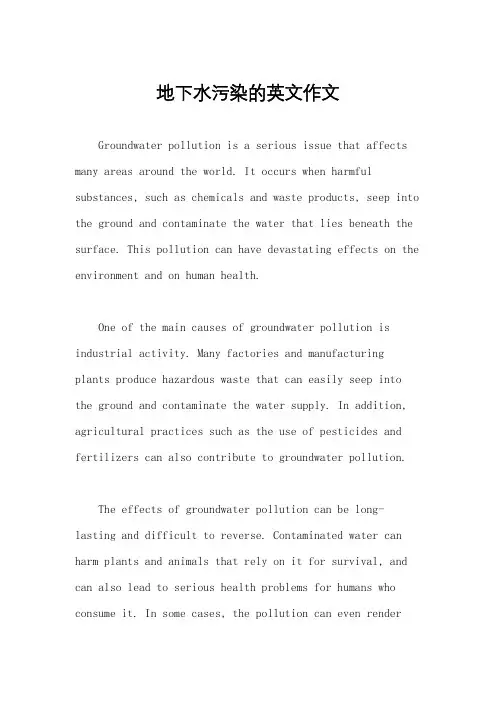
地下水污染的英文作文Groundwater pollution is a serious issue that affects many areas around the world. It occurs when harmful substances, such as chemicals and waste products, seep into the ground and contaminate the water that lies beneath the surface. This pollution can have devastating effects on the environment and on human health.One of the main causes of groundwater pollution is industrial activity. Many factories and manufacturing plants produce hazardous waste that can easily seep into the ground and contaminate the water supply. In addition, agricultural practices such as the use of pesticides and fertilizers can also contribute to groundwater pollution.The effects of groundwater pollution can be long-lasting and difficult to reverse. Contaminated water can harm plants and animals that rely on it for survival, and can also lead to serious health problems for humans who consume it. In some cases, the pollution can even renderthe water supply unusable, forcing communities to find alternative sources of water.Preventing groundwater pollution requires a concerted effort from individuals, businesses, and governments. This can involve implementing better waste management practices, reducing the use of harmful chemicals, and promoting sustainable agriculture. It is also important to monitor and regulate industrial activity to ensure that it does not contribute to groundwater pollution.Overall, groundwater pollution is a serious issue that requires immediate attention and action. By taking steps to prevent pollution and protect our water supply, we can ensure a healthier and more sustainable future for ourselves and for the planet.。
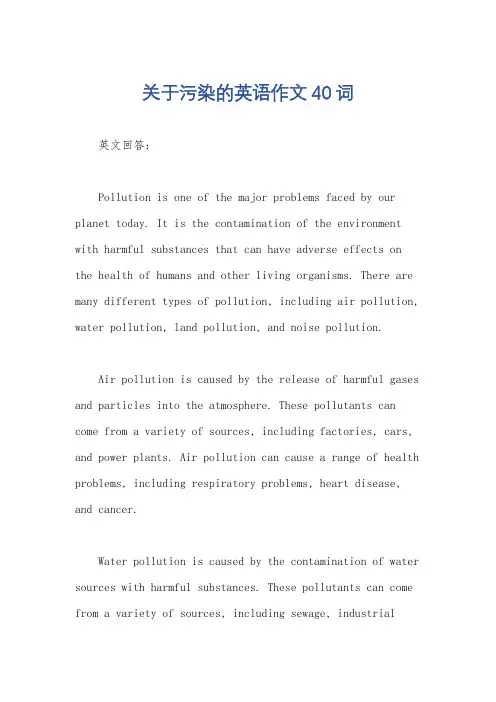
关于污染的英语作文40词英文回答:Pollution is one of the major problems faced by our planet today. It is the contamination of the environment with harmful substances that can have adverse effects on the health of humans and other living organisms. There are many different types of pollution, including air pollution, water pollution, land pollution, and noise pollution.Air pollution is caused by the release of harmful gases and particles into the atmosphere. These pollutants can come from a variety of sources, including factories, cars, and power plants. Air pollution can cause a range of health problems, including respiratory problems, heart disease, and cancer.Water pollution is caused by the contamination of water sources with harmful substances. These pollutants can come from a variety of sources, including sewage, industrialwaste, and agricultural runoff. Water pollution can cause a range of health problems, including gastrointestinal problems, skin infections, and cancer.Land pollution is caused by the contamination of land with harmful substances. These pollutants can come from a variety of sources, including industrial waste, mining operations, and landfills. Land pollution can cause a range of health problems, including soil contamination, groundwater contamination, and food contamination.Noise pollution is caused by the exposure to excessive levels of noise. These noise levels can come from a variety of sources, including traffic, construction, and industrial operations. Noise pollution can cause a range of health problems, including hearing loss, sleep disturbance, and stress.Pollution is a serious problem that has a negative impact on the health of humans and other living organisms. It is important to take steps to reduce pollution and protect our planet.中文回答:污染是我们星球今天面临的主要问题之一。
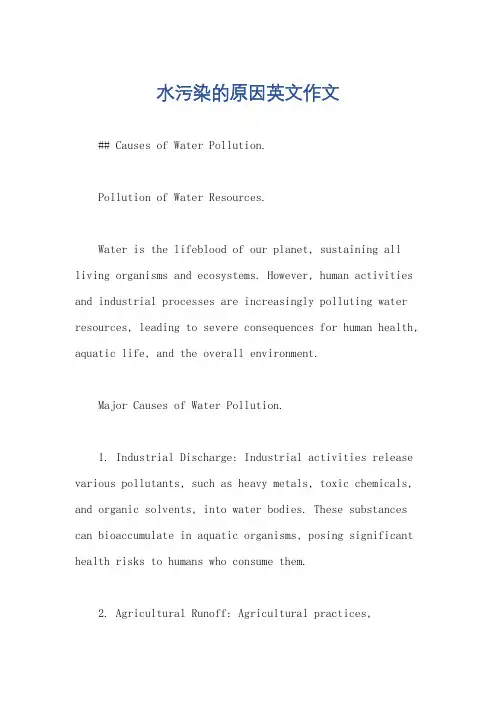
水污染的原因英文作文## Causes of Water Pollution.Pollution of Water Resources.Water is the lifeblood of our planet, sustaining all living organisms and ecosystems. However, human activities and industrial processes are increasingly polluting water resources, leading to severe consequences for human health, aquatic life, and the overall environment.Major Causes of Water Pollution.1. Industrial Discharge: Industrial activities release various pollutants, such as heavy metals, toxic chemicals, and organic solvents, into water bodies. These substances can bioaccumulate in aquatic organisms, posing significant health risks to humans who consume them.2. Agricultural Runoff: Agricultural practices,including the use of pesticides, herbicides, and fertilizers, contribute to water pollution. These chemicals can contaminate surface waters and groundwater, harming aquatic ecosystems and human water supplies.3. Municipal Wastewater: Untreated or poorly treated municipal wastewater, containing sewage and other contaminants, can pollute water bodies. This contamination can result in the spread of waterborne diseases, eutrophication, and harmful algal blooms.4. Oil and Gas Exploration: Offshore oil and gas drilling, transportation, and spills can lead to the release of hydrocarbons, heavy metals, and other pollutants into marine ecosystems. These substances can damage marine life, contaminate seafood, and disrupt ecosystem balance.5. Plastic Pollution: The improper disposal of plastic waste is a major contributor to water pollution. Plastic debris accumulates in waterways, oceans, and beaches, entangling marine life, blocking waterways, and releasing toxic chemicals.6. Deforestation and Land Use Changes: Deforestation and other land use changes alter watersheds, reducing the natural capacity of vegetation to filter pollutants and regulate water flow. This can result in increased sediment and nutrient runoff into water sources, which can harm aquatic ecosystems.7. Climate Change: Climate change is intensifyingwater-related extremes, such as floods, droughts, and storms. These events can erode shorelines, damage infrastructure, and exacerbate water pollution from various sources.## Water Pollution Causes in Chinese.水污染的原因。
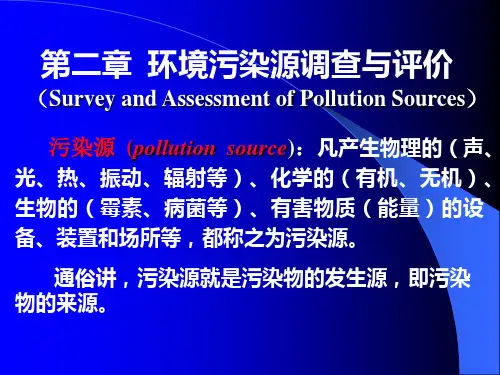
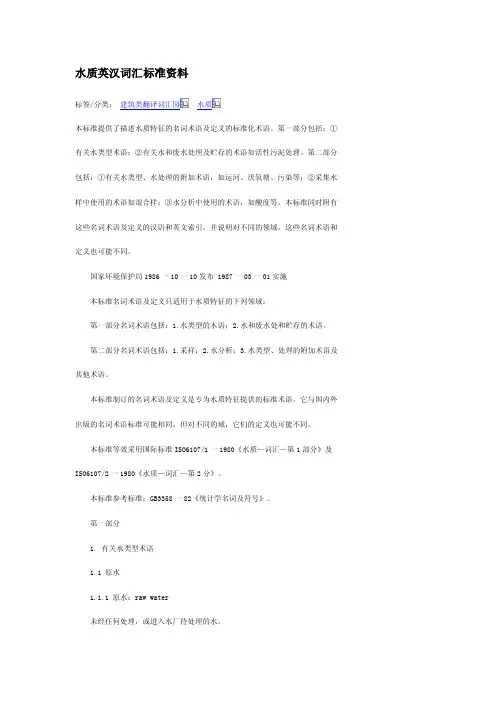
水质英汉词汇标准资料标签/分类:建筑类翻译词汇园水质本标准提供了描述水质特征的名词术语及定义的标准化术语。
第一部分包括:①有关水类型术语;②有关水和废水处理及贮存的术语如活性污泥处理。
第二部分包括:①有关水类型、水处理的附加术语,如运河、厌氧塘、污染等;②采集水样中使用的术语如混合样;③水分析中使用的术语,如酸度等。
本标准同时附有这些名词术语及定义的汉语和英文索引,并说明对不同的领域,这些名词术语和定义也可能不同。
国家环境保护局1986一10一10发布 1987一03一01实施本标准名词术语及定义只适用于水质特征的下列领域:第一部分名词术语包括:1.水类型的木语;2.水和废水处和贮存的术语。
第二部分名词术语包括:1.采祥;2.水分析;3.水类型、处理的附加术语及其他术语。
本标准制订的名词术语及定义是专为水质特征提供的标准术语。
它与国内外出版的名词术语标准可能相同,但对不同的域,它们的定义也可能不同。
本标准等效采用国际标准ISO6107/1一1980《水质—词汇—第1部分》及ISO6107/2一1980《水质—词汇—第2分》。
本标准参考标准:GB3358一82《统计学名词及符号》。
第一部分1. 有关水类型术语1.1 原水1.1.1 原水:raw water未经任何处理,或进入水厂待处理的水。
1.l.2 湖面温水层epilimnion在分层水体温跃层(Ll.10)上面的水。
1.1.3 地下水groundwater存于地下水层的水。
通常能从地下水层取出,或者通过地下水层取出的水。
l.1.4 湖底静水层hypolimniOn在分层水体温跃层下面的水。
1.1.5 寡营养的oligotrophic用于描述水体,指水体营养物质缺乏且含有种类较多而数量较少的水生生物。
这种水体的特征是透明度高,上层水体中氧的浓度高,底部沉积物通常呈浅褐色并仅含有少量的有机物。
1.1.6 雨水:rainwater尚未溶解地面上可溶性物质的大气降水。
关于水污染的英语作文带翻译英文回答:Water pollution is a serious issue that affects the health and well-being of people and the environment. There are many different sources of water pollution, including industrial waste, agricultural runoff, and improperdisposal of household chemicals. These pollutants can contaminate our drinking water, harm aquatic life, and disrupt ecosystems.For example, I remember a time when I visited a local river and saw trash and debris floating on the surface. It was a sad sight to see, and it made me realize how human activities can have such a negative impact on our waterways. The pollution not only made the river look unsightly, butit also posed a threat to the plants and animals that depend on the river for their survival.In addition to visible pollution, there are alsoinvisible pollutants that can be just as harmful. For instance, chemical fertilizers and pesticides used in agriculture can seep into groundwater and contaminate drinking water sources. This can lead to serious health problems for people who consume the contaminated water.It's important for us to take action to address water pollution and protect our water resources. This can be done through implementing stricter regulations on industrial waste disposal, promoting sustainable farming practices, and educating the public about the importance of proper waste management.中文回答:水污染是一个严重的问题,影响着人们的健康和环境的福祉。
水污染的原因英语作文英文回答:Water pollution is a serious problem that affects not only humans but also aquatic life. There are various causes of water pollution, including industrial activities, agricultural practices, and human activities.Industrial activities, such as chemical and oil spills, release harmful substances into water bodies. These substances can cause serious damage to aquatic life and contaminate water resources. Agricultural practices also contribute to water pollution through the use offertilizers and pesticides. These chemicals can seep into groundwater and contaminate water sources.Human activities, such as improper disposal of waste and sewage, also contribute to water pollution. This can result in the spread of diseases and harm to aquatic life. Additionally, activities such as boating and fishing canalso contribute to water pollution through the release of fuel and other pollutants.To address water pollution, it is important to implement effective regulations and policies to control industrial and agricultural practices. Proper waste management and sewage treatment systems should also be put in place to prevent the release of harmful substances into water sources. Individuals can also play a role in preventing water pollution by properly disposing of waste and being mindful of their impact on the environment.中文回答:水污染是一个严重的问题,不仅影响人类,也影响水生生物。
水污染自然原因英语作文Water pollution is a significant environmental issue that affects ecosystems, human health, and the economy worldwide. While human activities are often the primary cause of water pollution, natural factors also play a role in degrading water quality. In this essay, we will explore some of the natural causes of water pollution.1. Erosion: Natural erosion processes can contribute to water pollution by carrying sediments into water bodies. When soil erodes due to factors like rainfall, wind, or ice melt, it can transport various pollutants such as agricultural chemicals, heavy metals, and organic matter into rivers, lakes, and oceans. This sedimentation can degrade water quality, harm aquatic life, and disrupt ecosystems.2. Volcanic Activity: Volcanic eruptions release various gases, ash, and minerals into the atmosphere and water bodies. These substances can contain harmfulchemicals like sulfur dioxide, hydrogen sulfide, and heavy metals, which can contaminate water sources and affect aquatic ecosystems. Volcanic ash and debris can also clog waterways, leading to flooding and habitat destruction.3. Natural Toxins: Some algae, bacteria, and plants produce toxins naturally as part of their metabolic processes. For example, certain species of algae release toxins during blooms, which can occur due to factors like warm temperatures, sunlight, and nutrient pollution. These toxins, such as microcystins and saxitoxins, can posehealth risks to humans and wildlife if ingested or exposedto contaminated water.4. Geological Factors: Geological formations like rock strata and underground aquifers can influence water quality by leaching minerals and contaminants into groundwater and surface water. For instance, rocks containing arsenic, lead, or radon can release these substances into groundwater, rendering it unsafe for drinking and other uses. Additionally, natural underground reservoirs may become contaminated by pollutants from adjacent land areas orindustrial activities.5. Wildfires: Wildfires, which occur naturally in many ecosystems, can exacerbate water pollution by releasing ash, soot, and debris into waterways. These materials cancontain harmful substances such as heavy metals, organic pollutants, and nutrients, which can degrade water quality and harm aquatic organisms. Moreover, post-fire erosion and sedimentation can increase the turbidity of water bodiesand impair their ecological functions.6. Climate Change: While climate change is primarily driven by human activities, its impacts on natural processes can indirectly contribute to water pollution. For example, rising temperatures can lead to more frequent and intense storms, which increase runoff and erosion rates, transporting pollutants into water bodies. Climate-related changes in precipitation patterns can also affect the distribution and availability of water resources, exacerbating water scarcity and pollution issues in certain regions.In conclusion, while human activities are major contributors to water pollution, natural factors also play a significant role in degrading water quality. Understanding and addressing the interactions between natural processes and pollution sources are essential for effective water management and conservation efforts. By implementing sustainable practices and mitigating the impacts of both human-induced and natural causes of water pollution, we can work towards preserving this vital resource for future generations.。
英语作文水污染的原因Water pollution is a serious issue that affects our environment and health. There are several reasons behind water pollution. Industrial waste is one of the main contributors to water pollution. Many industries release harmful chemicals and toxins into rivers and oceans, contaminating the water and harming aquatic life.Another major cause of water pollution is agricultural runoff. Pesticides, fertilizers, and animal waste from farms can seep into water sources, leading to pollution and eutrophication. This can result in the growth of harmful algae and bacteria, making the water unsafe for drinking and recreation.Urban runoff is also a significant source of water pollution. Rainwater washes pollutants such as oil, trash, and chemicals from streets and parking lots into storm drains, which then flow into rivers and lakes. This can lead to contamination of water sources and harm to aquaticecosystems.Improper disposal of household waste is another reason for water pollution. Many people dump garbage, plastics, and other waste into rivers and oceans, causing harm to marine life and polluting the water. In addition, sewage discharge from homes and businesses can also contribute to water pollution, as untreated sewage contains harmful bacteria and pathogens.Overall, water pollution is a complex issue with multiple causes. It is important for individuals, industries, and governments to take action to reduce pollution and protect our water sources for future generations.。
水污染造成的原因英语作文Water pollution is caused by a variety of factors. Industrial waste, agricultural runoff, and untreated sewage are major contributors. These pollutants find their wayinto water bodies, contaminating them and posing a threat to aquatic life.Another significant cause of water pollution is the disposal of chemicals and hazardous materials. These substances can seep into the ground and eventually make their way into water sources, causing significant harm to the environment.Oil spills are also a major cause of water pollution. Accidents involving oil tankers or offshore drilling rigs can result in large quantities of oil being released into the water, leading to devastating consequences for marine ecosystems.Plastic pollution is a growing concern as well.Discarded plastic items, such as bottles and bags, often end up in water bodies, where they can harm marine life and contribute to the overall degradation of water quality.The improper disposal of household waste is yet another cause of water pollution. When garbage is not disposed of properly, it can end up in waterways, leading to contamination and posing a threat to both human health and the environment.In conclusion, water pollution is a complex issue with multiple causes. Addressing this problem requires a concerted effort to regulate industrial practices, improve waste management, and raise awareness about the importance of protecting our water resources.。
英语作文水污染的原因Water pollution is a serious environmental issue that has been caused by various factors. One of the main reasons for water pollution is industrial waste. Many industries release harmful chemicals and toxins into rivers, lakes, and oceans, which contaminate the water and harm aquatic life.Another major cause of water pollution is agricultural runoff. Farmers use fertilizers and pesticides on their crops, and when it rains, these chemicals can be washedinto nearby water sources, causing pollution. Additionally, animal waste from farms can also contribute to water pollution.Urbanization and population growth have also led to water pollution. As cities expand, more sewage and waste are produced, which can end up in water bodies if not properly treated. This can lead to the spread of diseases and harm to aquatic ecosystems.Oil spills are another significant cause of water pollution. Accidents involving oil tankers or offshore drilling can result in large amounts of oil being released into the ocean, causing devastating effects on marine life and ecosystems.Furthermore, littering and improper waste disposal by individuals also contribute to water pollution. Trash and plastic waste can end up in waterways, posing a threat to aquatic animals and the overall health of the water.In conclusion, water pollution is a complex issue caused by a combination of industrial, agricultural, and urban activities. It is essential for individuals, industries, and governments to take action to prevent further water pollution and protect our precious water resources.。